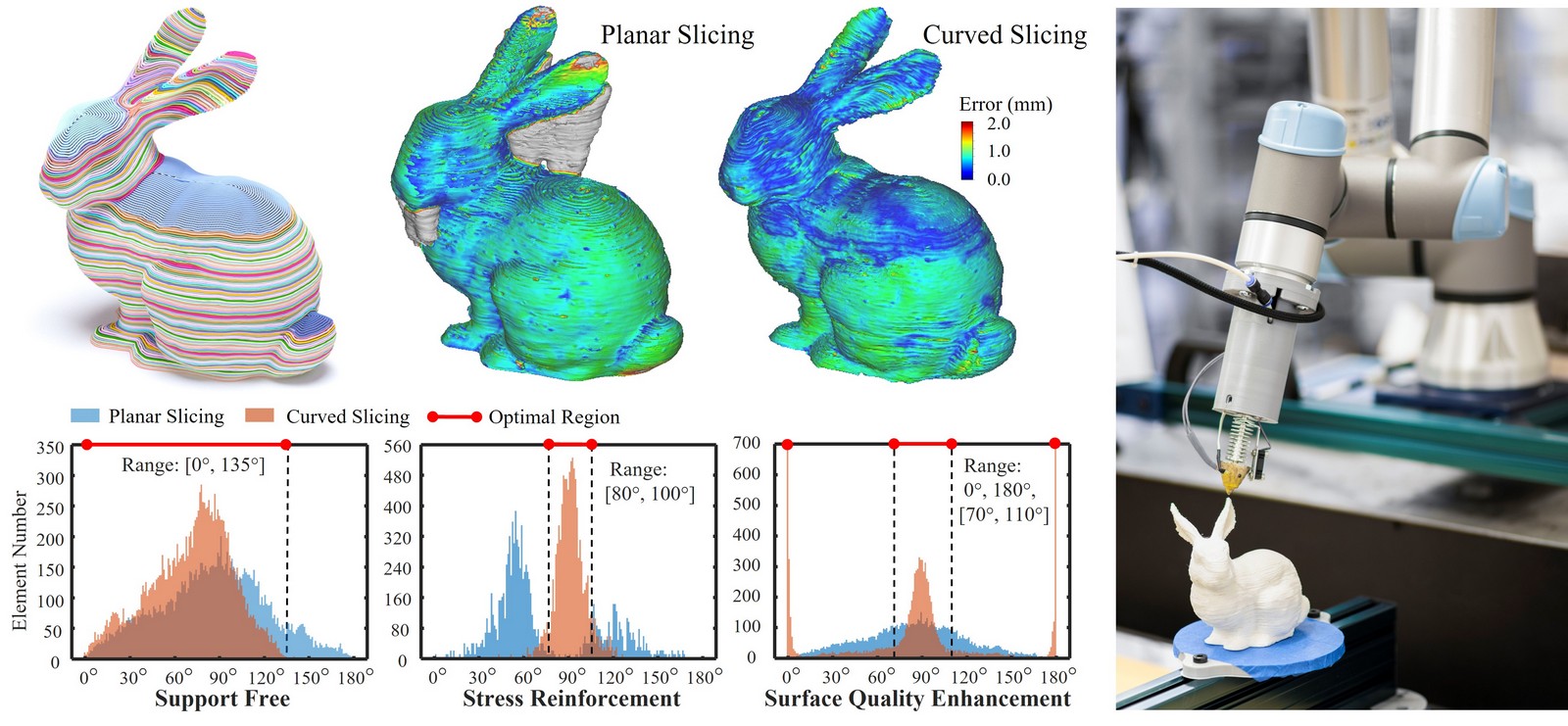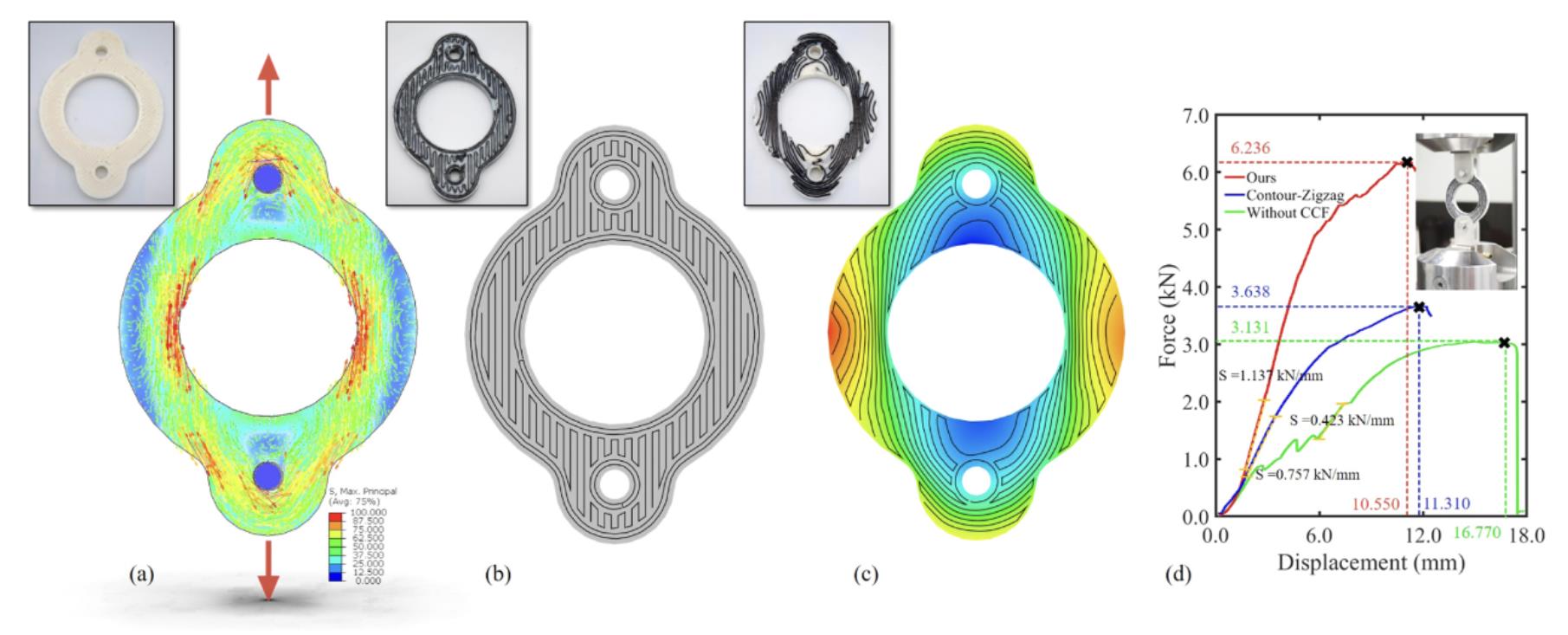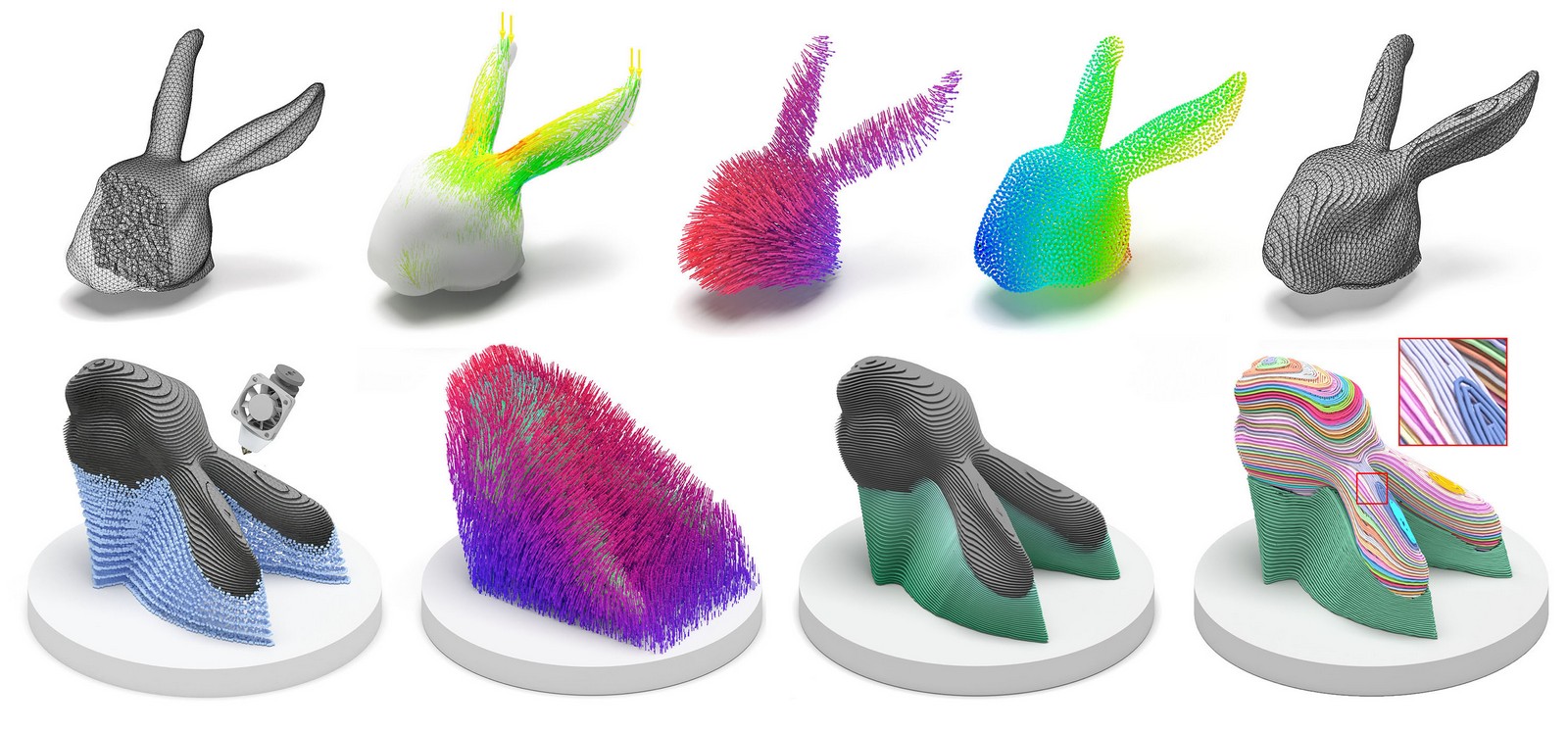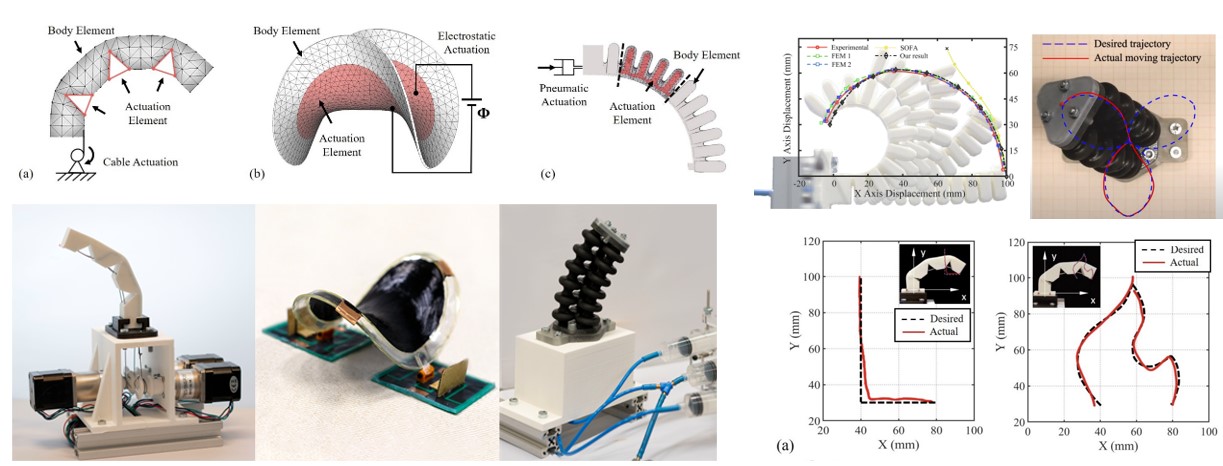
S^3-Slicer: A general slicing framework for multi-axis 3D printing
Tianyu Zhang*, Guoxin Fang*, Yuming Huang, Neelotpal Dutta, Sylvain Lefebvre, Zekai Murat Kilic, and Charlie C.L. Wang,
ACM Transactions on Graphics (SIGGRAPH Asia 2022), accepted, December 2022. [Video@YouTube]
(Best Paper Award - SIGGRAPH Asia 2022 Technical Papers)
Abstract: Multi-axis motion introduces more degrees of freedom into the process of 3D printing to enable different objectives of fabrication by accumulating materials layers upon curved layers. An existing challenge is how to effectively generate the curved layers satisfying multiple objectives simultaneously. This paper presents a general slicing framework for achieving multiple fabrication objectives including support free, strength reinforcement and surface quality. These objectives are formulated as local printing directions varied in the volume of a solid, which are achieved by computing the rotation-driven deformation for the input model. The height field of a deformed model is mapped into a scalar field on its original shape, the isosurfaces of which give the curved layers of multi-axis 3D printing. The deformation can be effectively optimized with the help of quaternion fields to achieve the fabrication objectives. The effectiveness of our method has been verified on a variety of models.

Jacobian-based Inverse Kinematics with Sim-to-Real Transfer of soft robots by Learning
Guoxin Fang, Yingjun Tian, Zhi-Xin Yang, Jo M.P. Geraedts, and Charlie C.L. Wang,
IEEE/ASME Transactions on Mechatronics (T-MECH), accepted, 2022. [Arxiv Link] [Video@YouTube]
Abstract: This paper presents an efficient learning-based method to solve the inverse kinematic (IK) problem on soft robots with highly non-linear deformation. The major challenge of efficiently computing IK for such robots is due to the lack of analytical formulation for either forward or inverse kinematics. To address this challenge, we employ neural networks to learn both the mapping function of forward kinematics and also the Jacobian of this function. As a result, Jacobian-based iteration can be applied to solve the IK problem. A sim-to-real training transfer strategy is conducted to make this approach more practical. We first generate a large number of samples in a simulation environment for learning both the kinematic and the Jacobian networks of a soft robot design. Thereafter, a sim-to-real layer of differentiable neurons is employed to map the results of simulation to the physical hardware, where this sim-to-real layer can be learned from a very limited number of training samples generated on the hardware. The effectiveness of our approach has been verified on pneumatic-driven soft robots for path following and interactive positioning.

Soft robotic mannequin: design and algorithm for deformation control
Yingjun Tian, Guoxin Fang, Justas Petrulis, Andrew Weightman, and Charlie C.L. Wang
IEEE/ASME Transactions on Mechatronics, August 2022. [arXiv] [Video@YouTube]
Abstract: This paper presents a novel soft robotic system for a deformable mannequin that can be employed to physically realize the 3D geometry of different human bodies. The soft membrane on a mannequin is deformed by inflating several curved chambers using pneumatic actuation. Controlling the freeform surface of a soft membrane by adjusting the pneumatic actuation in different chambers is challenging as the membrane's shape is commonly determined by interaction between all chambers. Using vision feedback provided by a structured-light based 3D scanner, we developed an efficient algorithm to compute the optimized actuation of all chambers which could drive the soft membrane to deform into the best approximation of different target shapes. Our algorithm converges quickly by including the step of pose estimation in the loop of optimization, and the time-consuming step for evaluating derivatives on the deformable membrane is avoided by using the Broyden update when possible. The effectiveness of our soft robotic mannequin with controlled deformation has been verified in experiments.

Field-based toolpath generation for 3D printing continuous fibre reinforced thermoplastic composites
Xiangjia Chen*, Guoxin Fang*, Wei-Hsin Liao, and Charlie C.L. Wang
Additive Manufacturing, vol.49, 102470 (13 pages), January 2022. [arXiv] [Dataset of Examples] [Video@YouTube]
Abstract: We present a field-based method of toolpath generation for 3D printing continuous fibre reinforced thermoplastic composites. Our method employs the strong anisotropic material property of continuous fibres by generating toolpaths along the directions of tensile stresses in the critical regions. Moreover, the density of toolpath distribution is controlled in an adaptive way proportionally to the values of stresses. Specifically, a vector field is generated from the stress tensors under given loads and processed to have better compatibility between neighboring vectors. An optimal scalar field is computed later by making its gradients approximate the vector field. After that, isocurves of the scalar field are extracted to generate the toolpaths for continuous fibre reinforcement, which are also integrated with the boundary conformal toolpaths in user selected regions. The performance of our method has been verified on a variety of models in different loading conditions. Experimental tests are conducted on specimens by 3D printing continuous carbon fibres (CCF) in a polylactic acid (PLA) matrix. Compared to reinforcement by load-independent toolpaths, the specimens fabricated by our method show up to 71.4% improvement on the mechanical strength in physical tests when using the same (or even slightly smaller) amount of continuous fibres.

Sensing and reconstruction of 3D deformation on pneumatic soft robots
Rob B.N. Scharff, Guoxin Fang, Yingjun Tian, Jun Wu, Jo M.P. Geraedts, and Charlie C.L. Wang
IEEE/ASME Transactions on Mechatronics, vol.26, no.4, pp.1877-1885, August 2021. [arXiv] [Video@YouTube]
Abstract: Real-time proprioception is a challenging problem for soft robots, which have almost infinite degrees-of-freedom in body deformation. When multiple actuators are used, it becomes more difficult as deformation can also occur on actuators caused by interaction between each other. To tackle this problem, we present a method in this paper to sense and reconstruct 3D deformation on pneumatic soft robots by first integrating multiple low-cost sensors inside the chambers of pneumatic actuators and then using machine learning to convert the captured signals into shape parameters of soft robots. An exterior motion capture system is employed to generate the datasets for both training and testing. With the help of good shape parameterization, the 3D shape of a soft robot can be accurately reconstructed from signals obtained from multiple sensors. We demonstrate the effectiveness of this approach on two designs of soft robots - a robotic joint and a deformable membrane. After parameterizing the deformation of these soft robots into compact shape parameters, we can effectively train the neural networks to reconstruct the 3D deformation from the sensor signals. The sensing and shape prediction pipeline can run at 50Hz in real-time on a consumer-level device.

Reinforced FDM: Multi-axis filament alignment with controlled anisotropic strength
Guoxin Fang, Tianyu Zhang, Sikai Zhong, Xiangjia Chen, Zichun Zhong, and Charlie C.L. Wang
ACM Transactions on Graphics (SIGGRAPH Asia 2020), November 2020. [Project] [PDF] [Source Code] [Video@YouTube]
Abstract: The anisotropy of mechanical strength on a 3D printed model can be controlled in a multi-axis 3D printing system as materials can be accumulated along dynamically varied directions. In this paper, we present a new computational framework to generate specially designed layers and toolpaths of multi-axis 3D printing for strengthening a model by aligning filaments along the directions with large stresses. The major challenge comes from how to effectively decompose a solid into a sequence of strength-aware and collision-free working surfaces. We formulate it as a problem to compute an optimized governing field together with a selected orientation of fabrication setup. Iso-surfaces of the governing field are extracted as working surface layers for filament alignment. Supporting structures in curved layers are constructed by extrapolating the governing field to enable the fabrication of overhangs. Compared with planar-layer based Fused Deposition Modeling (FDM) technology, models fabricated by our method can withstand up to 6.35x loads in experimental tests.

Kinematics of soft robots by geometric computing
Guoxin Fang, Christopher-Denny Matte, Rob B.N. Scharff, Tsz-Ho Kwok†, and Charlie C.L. Wang†
IEEE Transactions on Robotics, vol.36, no.4, pp.1272-1286, August 2020. [PDF] [Source Code] [Video@YouTube]
Abstract: Robots fabricated with soft materials can provide higher flexibility and thus better safety while interacting in unpredictable situations. However, the usage of soft material makes it challenging to predict the deformation of a continuum body under actuation and therefore brings difficulty to the kinematic control of its movement. In this paper, we present a geometry-based framework for computing the deformation of soft robots within the range of linear material elasticity. After formulating both manipulators and actuators with geometry elements, deformation can be efficiently computed by solving a constrained optimization problem. Based on its efficiency, forward and inverse kinematics for soft manipulators can be effectively solved by an iterative algorithm. Meanwhile, components with multiple materials can also be geometrically modeled in our framework with the help of a simple calibration. Numerical and physical experimental tests are conducted on soft manipulators driven by different actuators with large deformation to demonstrate the performance of our approach.
Please check publications before 2020 on my google scholar page.
Collision-Aware Fast Simulation for Soft Robots by Optimization-Based Geometric Computing,
Guoxin Fang*, Yingjun Tian*, Andrew Weightman, and Charlie C.L. Wang.
IEEE/RSJ International Conference on Intelligent Robots and Systems (IROS 2022),
[Arxiv Link] [Video@YouTube] [Source Code]
(2nd place of the best workshop poster competition, 2022 IEEE RoboSoft Conference)
Singularity-aware motion planning for multi-axis additive manufacturing
Tianyu Zhang, Xiangjia Chen, Guoxin Fang, Yingjun Tian, and Charlie C.L. Wang,
Presented at IEEE International Conference on Automation Science and Engineering (CASE 2021), Lyon, France, August 23-27, 2021,
IEEE Robotics and Automation Letters, vol.6, no.4, pp.6172-6179, October 2021. [arXiv] [Source Code] [Video@YouTube]
(Finalist of Best Student Paper Award)
Controlling Multi-segment Soft Robot for Grasping
Guoxin Fang, Rob B.N. Scharff, and Charlie C.L. Wang,
IEEE International Conference on Automation Science and Engineering, 2019, Vancouver (CASE 2019 short paper) [PDF]
Geometry-based Direct Simulation for Multi-Material Soft Robots
Guoxin Fang, Christopher-Denny Matte, Tsz-Ho Kwok, and Charlie C.L. Wang,
IEEE International Conference on Robotics and Automation 2018 (ICRA 2018) [PDF] [Video@YouTube]
Thermal-comfort design of personalized casts
Xiaoting Zhang, Guoxin Fang, Chengkai Dai, Jouke Verlinden, Jun Wu, Emily Whiting, and Charlie C.L. Wang,
ACM Symposium on User Interface Software and Technology (UIST 2017), pp.243-254, Quebec City, Canada. [PDF] [Video@YouTube]
RoboFDM: a robotic system for support-free fabrication using FDM
Chenming Wu, Chengkai Dai, Guoxin Fang, Yong-Jin Liu, and Charlie C.L. Wang,
IEEE International Conference on Robotics and Automation (ICRA 2017), [PDF] [Video@YouTube]
OpenPneu: Compact platform for pneumatic actuation with multi-channels, under review.
Yingjun Tian, Renbo Su, Xilong Wang, Nur Banu Altin, Guoxin Fang†, and Charlie C.L. Wang†
[Video@YouTube] [Project Page] [ArXiv]
Abstract: This paper presents a compact system, OpenPneu, to support the pneumatic actuation for multi-chambers on soft robots. Micro-pumps are employed in the system to generate airflow and therefore no extra input as compressed air is needed. Our system conducts modular design to provide good scalability, which has been demonstrated on a prototype with ten air channels. Each air channel of OpenPneu is equipped with both the inflation and the deflation functions to provide a full range pressure supply from positive to negative with a maximal flow rate at 1.7 L/min. High precision closed-loop control of pressures has been built into our system to achieve stable and efficient dynamic performance in actuation. An open-source control interface and API in Python are provided. We also demonstrate the functionality of OpenPneu on three soft robotic systems with up to 10 chambers.
Support generation for robot-assisted 3D printing with curved layers
, under review.
Tianyu Zhang, Yuming Huang, Piotr Kukulski, Neelotpal Dutta, Guoxin Fang, and Charlie C.L. Wang
Abstract: Robot-assisted 3D printing has drawn a lot of attention by its capability to fabricate curved layers that are optimized according to different objectives. However, the support generation algorithm based on a fixed printing direction for planar layers cannot be directly applied for curved layers as the orientation of material accumulation is dynamically varied. In this paper, we propose a skeleton-based support generation method for robot-assisted 3D printing with curved layers. The support is represented as an implicit solid so that the problems of numerical robustness can be effectively avoided. The effectiveness of our algorithm is verified on a dual-material printing platform that consists of a robotic arm and a newly designed dual-material extruder. Experiments have been successfully conducted on our system to fabricate a variety of freeform models.